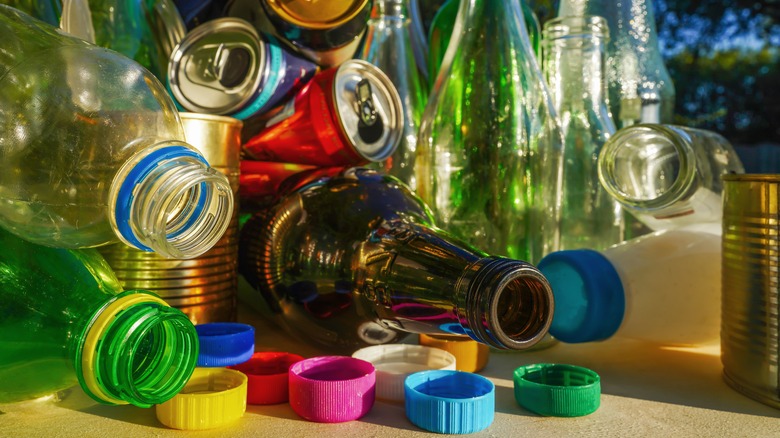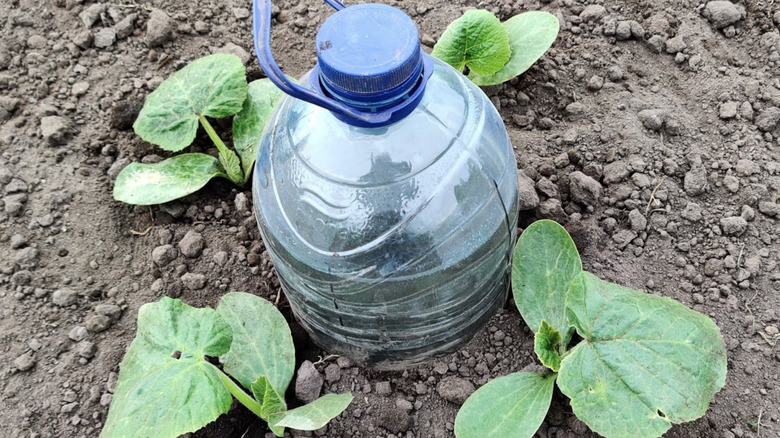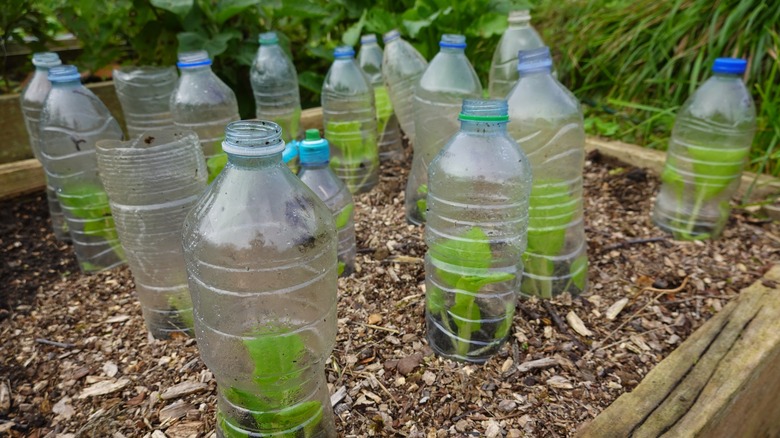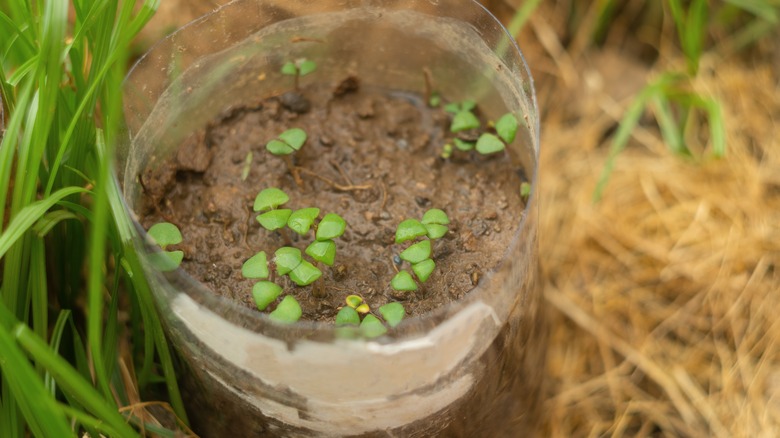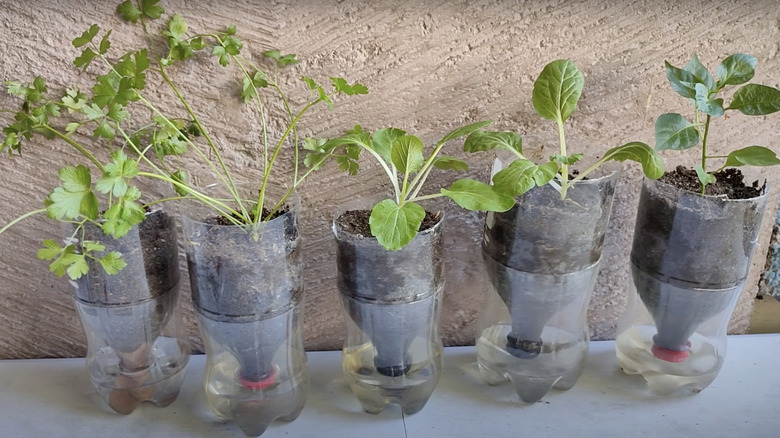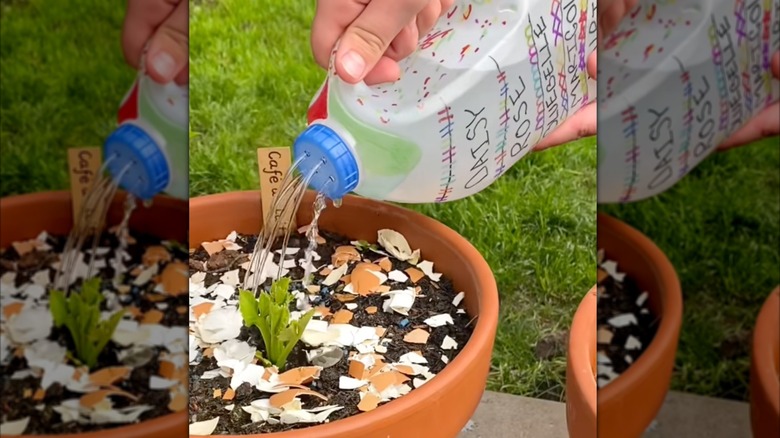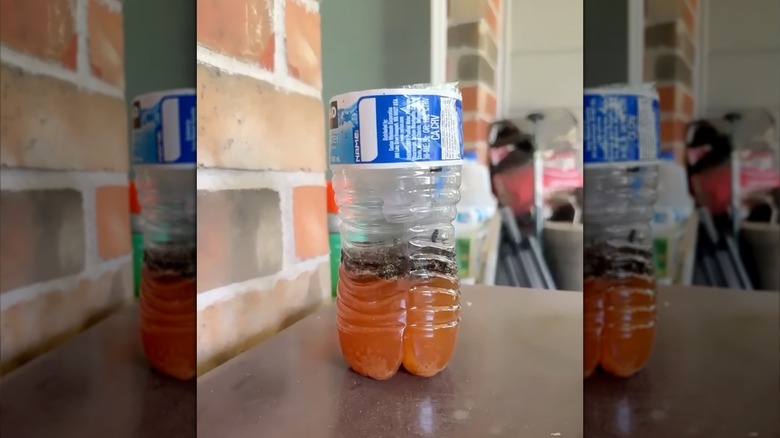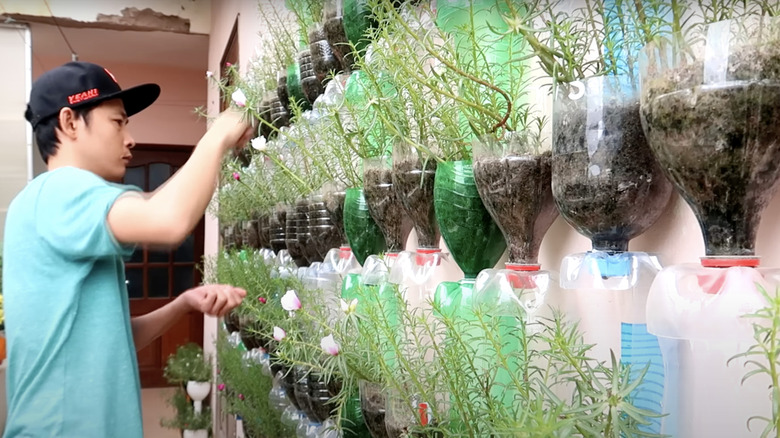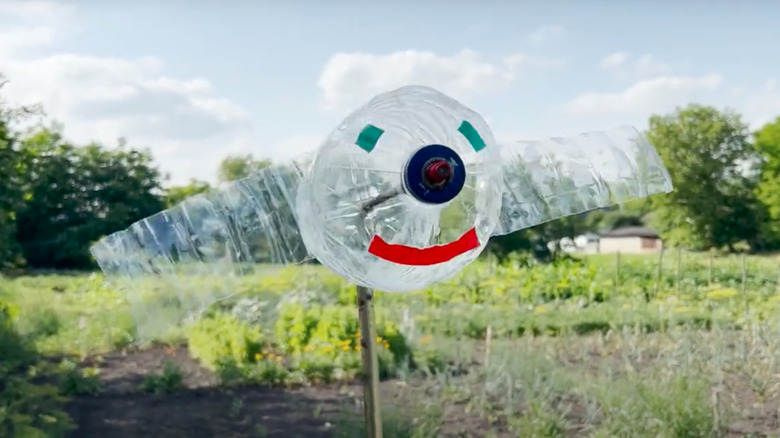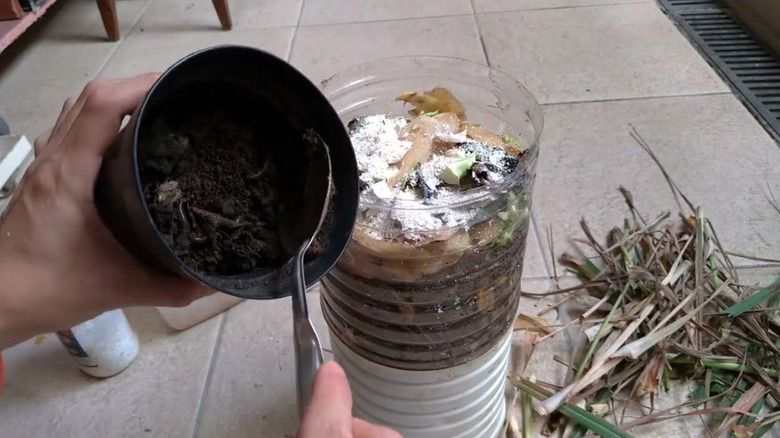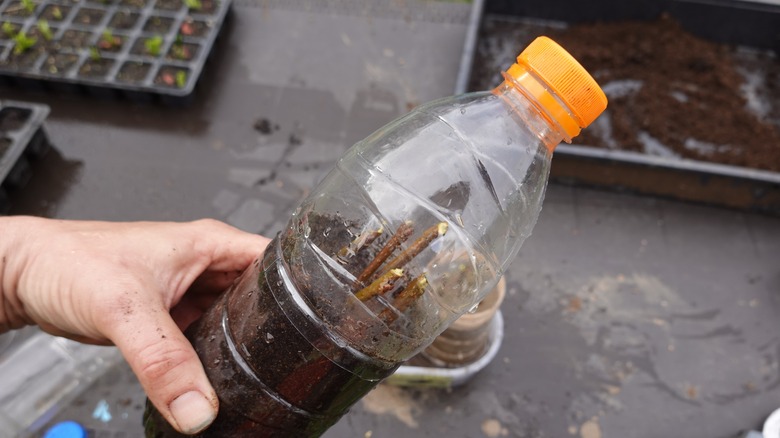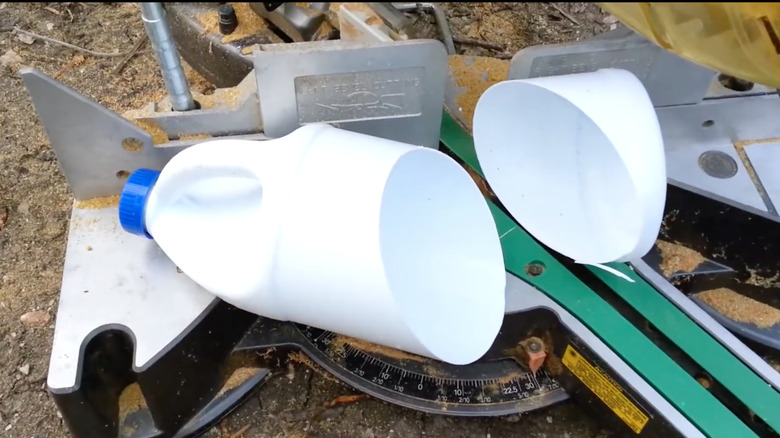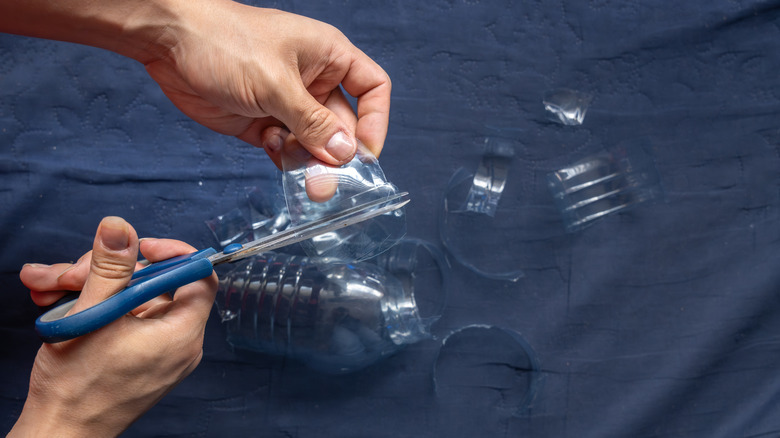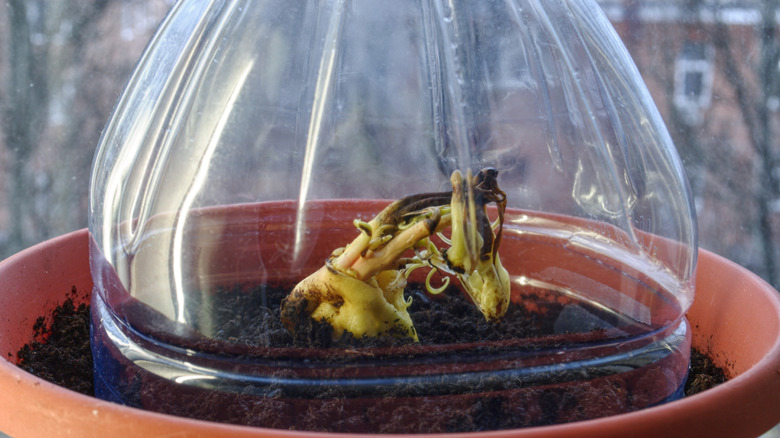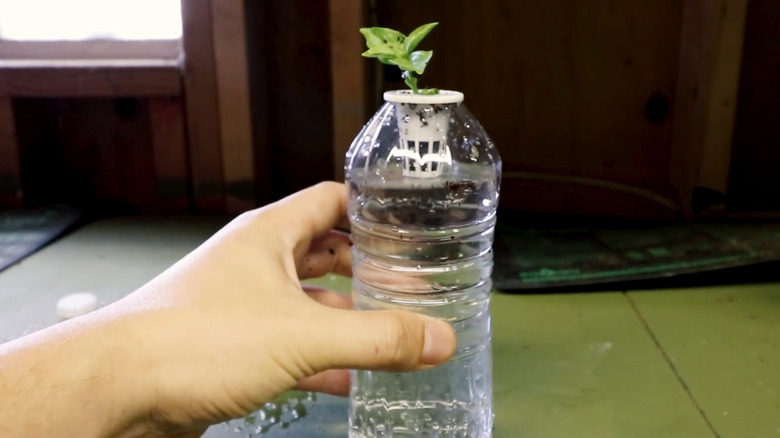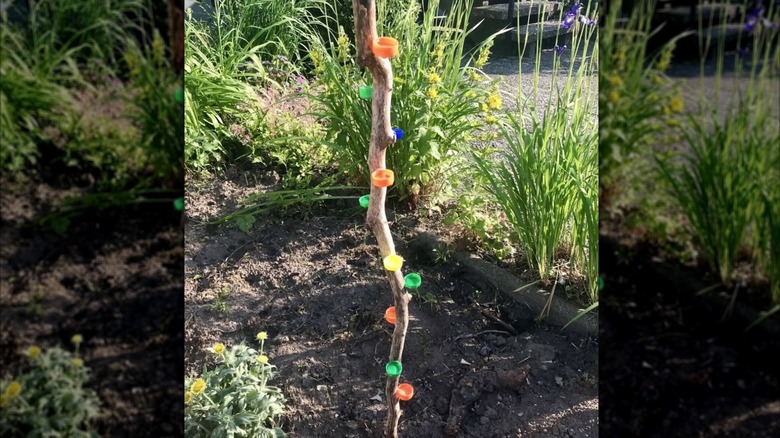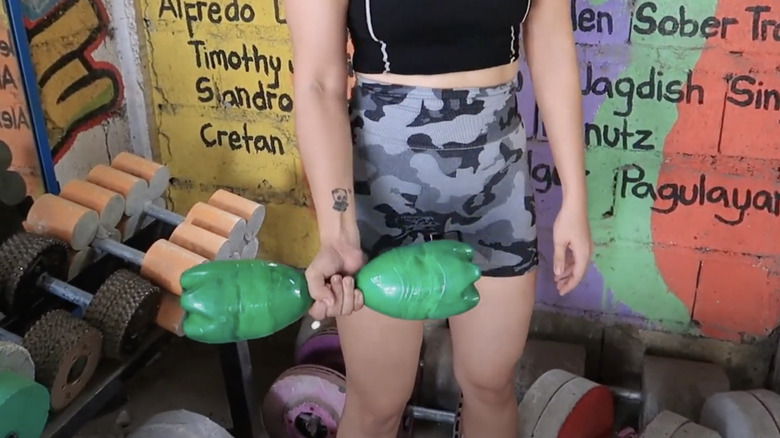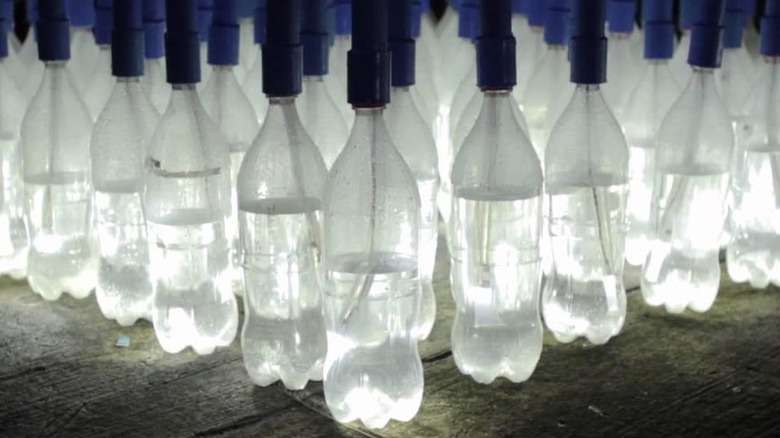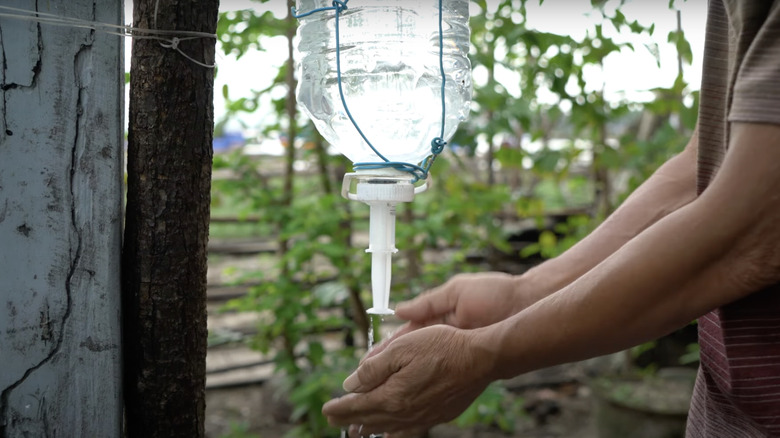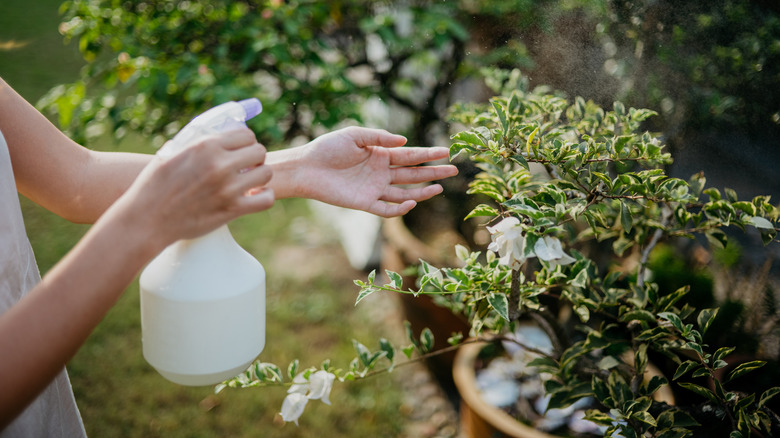22 Savvy Ways To Reuse Empty Plastic Bottles In The Garden
Do you ever toss a plastic bottle in the recycling bin and wonder where it actually ends up? You're not alone, and unfortunately, a lot of it doesn't make it very far. In 2019, the U.S. generated about 73 million metric tons of plastic waste, and that number is expected to double by 2060. Plastic bottles and packaging make up a big part of that, and most are used once and then thrown away.
But it doesn't have to be that way. With a little creativity, those bottles can find a second life in your garden. Plastic bottles are surprisingly versatile. They're lightweight, waterproof, easy to cut, and durable enough to withstand sun, rain, and soil. That makes them ideal for all kinds of garden hacks. Whether you're starting seeds, watering plants, or feeding birds, reusing bottles can help you cut down on waste while saving money on supplies.
You can turn them into self-watering planters, propagation domes, or mini greenhouses. Use them to make sturdy scoopers, vertical kitchen herb gardens, plant tags, homemade bird feeders, or even a simple hydroponics system. These projects are practical, low-cost, and often work just as well, if not better, than store-bought tools. Plus, they're a great way to learn more about sustainable gardening and reduce your footprint one bottle at a time.
Drip irrigation bottle
You can easily turn an empty plastic bottle into a slow-release watering system. Start by poking a few small holes in the cap and near the bottom sides of the bottle. Bury the bottom part of the bottle next to your plant, leaving the top exposed. Fill it with water and screw the cap back on. The water will gradually seep into the soil, keeping it evenly moist without soaking the roots. It's a great way to prevent overwatering and is perfect for raised beds, container gardens, or when you're away for a few days.
Plastic bottle cloche
Turn a plastic bottle into a mini greenhouse by cutting off the bottom and placing it over young plants or seedlings. It traps warmth and moisture, giving your plants a better start while shielding them from wind, pests, and chilly nights. On warmer days, just unscrew the cap to let in some air. This simple trick is especially useful in early spring and works surprisingly well. It's a free, low-effort way to extend your growing season without buying fancy cloches.
Seed-starting pots
Instead of tossing that empty plastic bottle, cut it in half and use the bottom as a seed-starting pot. Just cut a few drainage holes in the bottom, fill it with seed-starting mix, and plant your seeds. It is even better if the bottle is clear because you'll be able to keep an eye on moisture and root growth. Don't forget to label each one so you know what's growing where. Once your seedlings are ready, you can move them into the garden or larger containers.
Self-watering planters
For an easy self-watering setup, cut a plastic bottle in half and flip the top part upside down into the bottom half. Thread a cotton string or fabric strip through the cap to act as a wick. Add water to the bottom, then fill the top with soil and a plant. The wick slowly pulls water up as needed, keeping the soil moist without constant attention. It's perfect for herbs, small veggies, or houseplants, especially if you're busy, forgetful, or away for a few days.
DIY watering can
Try turning an old plastic bottle into a makeshift watering can. Take a bottle with a screw-on cap and poke a few small holes in the lid using a pin or nail. Fill it with water, screw the cap back on, and give it a squeeze. Water will come out in a soft, even stream, which is perfect for delicate seedlings or indoor pots. It's an easy, kid-friendly project and a great way to reuse what you already have.
DIY bug trap
You can turn a plastic bottle into an easy bug trap to cut down on pests without using any harsh sprays. Just cut off the top third and flip it upside down into the bottom to make a funnel. Add a bit of sugary water, vinegar, beer, or whatever suits the type of pest you're dealing with. The smell draws them in, but once inside, they can't get back out.It's a simple, chemical-free solution for cutting down on bugs near compost bins and a clever way to keep things calmer in the garden.
Vertical bottle garden
If you're short on space, try making a vertical garden out of old plastic bottles. Cut a rectangular opening in each one, fill it with soil, and plant shallow-rooted greens like lettuce, herbs, or small flowers. Punch holes in the top and bottom, then thread string or wire through to hang them on a wall or fence. Suspend several bottles on top of each other, making sure each one has drainage holes. Then the water can trickle down and water plants below.
DIY bird scare
You can use a plastic bottle to make a simple garden scare device. Cut flaps into the sides and mount the bottle on a stick or pole so it spins when the wind blows. The motion and soft rattling noise can help scare off birds, squirrels, and other curious critters. For extra impact, add strips of shiny tape or foil to catch the light. It's not a foolproof fix, but it's a fun, zero-cost way to protect your fruit and vegetable beds from damage.
Mini compost bottle
Got kitchen scraps but no room for a full compost bin? A plastic bottle is all you need to get started. Cut off the top, poke holes in the sides for airflow, and start layering food waste, dry leaves, and a bit of soil. Keep it slightly moist and give it a shake or stir now and then. It's a great way to try composting if you're working with less space or just starting out. Once it breaks down, you can mix the compost into pots or beds. It's a small step toward reducing waste.
Plastic bottle funnel
You can make a funnel from a plastic bottle by cutting off the bottom and making a small hole in the cap. If you want more control while pouring, push part of an old pen or straw into the hole to act as a spout. Use glue if needed to hold it in place. This helps guide soil, sand, or liquids without spilling. If you're drilling the cap, screw it onto the bottle first so it's easier to hold safely. Try different bottle sizes to match whatever task you're working on.
Plastic bottle propagator
If you've got a few cuttings and no fancy setup, a plastic bottle works surprisingly well as a mini greenhouse. Slice it in half, poke drainage holes in the base, and add moist soil mixed with a bit of sand or compost. Gently press your cuttings in, making sure at least two nodes are buried. Place the top half back on to seal in warmth and moisture. It creates the perfect humid space for roots to form. This trick works with bottles of all sizes and is a great way to multiply your favorite plants for free.
DIY rain gauge
Make a simple rain gauge by cutting the top off a clear bottle and marking measurements up the side in centimeters or inches. Cut off the top, flip it upside down like a funnel, and place it into the base. Then, add a few stones to the bottom so it doesn't tip over. Use a ruler and permanent marker for the measurements on the outside. Set it in a flat, open area where it can collect rain easily. Just be sure to check and empty it regularly and use a tall bottle.
Plastic bottle scoop
Do you need a quick scooper for garden chores? Grab an old plastic bottle and cut it at an angle to make a simple, pointed scoop. The neck acts as a built-in handle, making it easy to grip while you work. Go for a sturdier bottle so it doesn't bend while scooping compost, fertilizer, or soil. You can shape it smaller for seed trays or larger for mulch, whatever fits the job. It takes just a few minutes to make and saves you the trouble of buying a separate tool.
Homemade bird feeder
You can make a super simple bird feeder out of an old plastic bottle, sticksor spoons, and some string. Start by poking a few holes at the bottom for drainage. Then, push a stick through the lower part of the bottle to create a perch, leaving enough sticking out on both sides for birds to land on. Cut small openings just above the perch for food access. Do the same thing higher up, placing the next set of holes at a different angle. Add a string at the top, fill it with birdseed, and hang it outside.
Bottle plant tags
If you're always forgetting where you planted what, try making your own plant labels from an old plastic bottle. Just cut it into strips and write the names with a permanent marker. You can stick them straight into the soil, tape them onto pots, or even tie them to a stake if you punch a little hole at the top. Unlike cardboard or wood, plastic doesn't turn to mush when it rains, so these actually last. It's a quick fix, and super helpful when you're growing more than a few things at once.
Seedling bottle cover
Plastic bottles are surprisingly handy when you're starting seeds. After sowing, you can cover each pot or tray with the bottom half of a clear bottle. It helps hold in moisture, something most seeds need to germinate well, and keeps small seeds like basil or lettuce from getting washed away by watering or sudden rain. It also stops soil from splashing out, especially if you're growing outdoors. Just mist the surface lightly to keep it moist, and once your seedlings are up, you can either remove the cover or leave it in place as a low barrier.
Bottle hydroponic planter
Want to try growing herbs without soil? Turn a plastic bottle into a super simple hydroponic setup. Cut the bottle in half, fill the bottom with water and nutrients, and flip the top upside down so it sits like a funnel. Pop a small net pot or cup with your plant inside, making sure a cotton wick or a bit of fabric runs through the cap to pull water up. It's great for basil, mint, or small leafy greens. Set it on a sunny windowsill and watch it grow with no mess and no soil.
Bee watering station
Pollinators like bees and butterflies need a safe place to drink, so use a plastic bottle to make a mini watering bar for them. Grab a stick or wooden dowel and glue the plastic bottle caps along its length using hot glue. Once it's dry, stick the whole setup into a flower bed, garden pot, or anywhere bees are likely to visit. Fill the caps with water, nearly to the top, so thirsty pollinators can safely land and drink without tipping over. Make sure that you choose a spot with light shade and shelter from the wind.
Bottle garden weights
Plastic bottles make great weights for holding down row covers, frost cloths, or bird netting. Fill them with sand or water, cap them tightly, and place them along the edges to keep everything in place during windy weather. They're easy to move when needed and won't damage the soil or roots. You can even shape them like dumbbells or decorate them to blend into your garden, so they don't look like random clutter.
Daylight bottle light
There's a simple way to brighten the dark corners of your garden or shed during the day using just a plastic bottle, water, and a bit of chlorine. Fill a clear bottle, seal it tightly, and fit it into a hole in the roof or wall where sunlight hits. The water bends and spreads the light, creating a natural glow indoors, almost like switching on a bulb. It's a clever way to reuse plastic and bring free daylight into spaces that would otherwise stay dim.
Syringe tap bottle
You can make a simple outdoor hand-washing setup using a plastic bottle and an old syringe. Cut off the top half of the syringe and make a hole in the bottle cap just big enough to fit it. Insert the syringe nozzle into the cap and seal it tightly with glue. Hang the bottle upside down on a branch or fence. When you push the syringe plunger upward, it releases a small stream of water that is just enough to rinse your hands.
Plastic bottle mister
Empty soda bottles don't have to end up in the trash. You can turn one into a plant mister with a simple upgrade. Rinse the bottle well and remove any branding or labels. To give it a fresh look, you can decorate it with tape or paint. Then, get a pump-action sprayer head made to fit plastic beverage bottles. You can even keep a second bottle on hand for homemade pest repellent sprays like diluted neem oil or garlic water.
